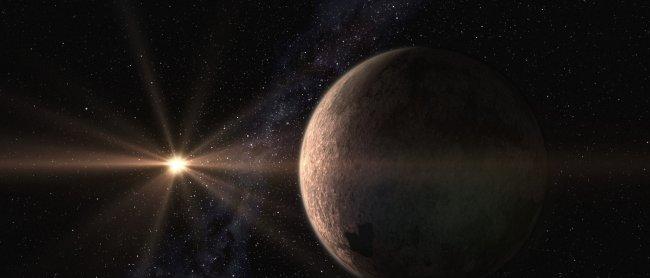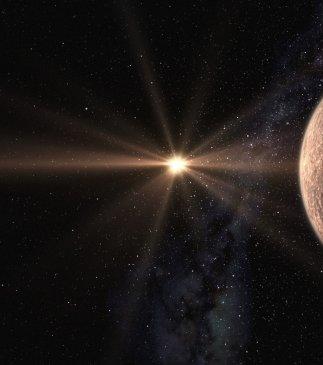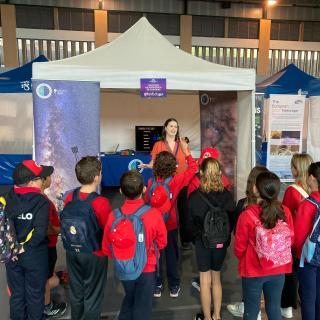CAPTION: Artistic design of the super-Earth GJ 625 b and its star, GJ625 (Gliese 625). Credit: Gabriel Pérez, SMM (IAC).
Only 25 years ago we did not know of any planets outside the Solar System. Today, though, we have a list of more than 3,500 exoplanets around other stars. There are a number of techniques for discovering them, and one of the most used is the radial velocity technique. This involves measuring the changes in the position and velocity of a star when the star and a planet in orbit around it rotate around their common centre of gravity. Depending on the relative masses of the two objects gravity will determine the magnitude of the change in velocity of the star, which can be measured using its observed spectrum.
Using this method, a study conducted by the researchers Alejandro Suárez Mascareño of the IAC-Geneva Observatory, Jonay González Hernández (IAC) and Rafael Rebolo(IAC) has led to the discovery of a planet with a mass between two and three times the Earth that could be rocky. This is the sixth super-Earth closest to our solar system in the habitaiblity zone of its star, a red dwarf that is among the 100 stars closest to the Sun. The results of this work, in which there has also been participation from the INAF (Instituto Nazionale di Astrofísica) the IEEC (Instituí d?Estudis Espaciais de Catalunya) and the TNG (Telescopio Nazionale Galileo) have been accepted for publication in the journal Astronmy & Astrophysics.
This planet is particularly interesting because of its proximity. It is only 21 light years away, in our cosmic neighbourhood, it is one of the least massive of the known "Super-Earths", which in addition is situated in the habitability zone of the star GJ625 (Gliese 625), a red dwarf. Even those these are the most common stars in the universe and they can host planets, we know only a few hundred of them. The majority have been discovered orbiting much more distant stars, using the transit method, in which the planet causes a minor "eclipse" when it passes in front of the star. In contrast, only a few done rocky planets have been discovered around nearby stars with the radial velocity technique, and very few have been found in their habitability zones.
One of the projects which this scientific team is carrying out in order to study exoplanets around red dwarf close to the Sun is HADES, a programme in which the high resolution spectrograph HARPS-N has detected this Super-Earth. This instrument, on the 3.6m Telescopio Nazionale Galileo (TNG) at the Roque de Los Muchachos Observatory (Garafía, La Palma), observed the red dwarf for three years, and measured the small variations of its radial velocity caused by the gravitational full of the planet.
Con los 151 espectros que obtuvieron, dedujeron que el mismo tarda unos 14 días en dar una vuelta alrededor de su estrella en una órbita cercana. “Como GJ625 es una estrella relativamente fría –explica Alejandro Suárez Mascareño, primer autor del estudio- el planeta se encontraría en el borde de la zona de habitabilidad, donde podría existir agua líquida. Además, dependiendo de la cobertura de nubes de su atmósfera y de su rotación, podría ser potencialmente habitable”.
With the 151 spectra which they obtained, they inferred that the planet take some 14 days to complete one orbit around its star, on a very close one. "As GJ625 is a relatively cool star" explains Alejandro Suárez Mascareño" the planet is situated at the edge of its habitability zone, in which liquid water can exist on its surface. In fact, depending on the cloud cover of its atmosphere and on its rotation, it could potentially be habitable".
"In the future" comments Jonay González Hernández "new observing campaigns of photometric observations will be essential to try to detect the transit of this planet across its star, given its proximity to the Sun. There is a possibility that there are more rocky planets around GJ625 in orbits which are nearer to, or further away from the star, and within the habitability zone, which we will keep on combing".
"The detection of a transit will allow us to determine its radius and its density, and will allow us to characterize its atmosphere by the transmitted light observe using high resolution high stability spectrographs on the GTC or on telescopes of the next generation in the northern hemisphere, such as the Thirty Meter Telescope (TMT)", concludes Rafael Rebolo.
Article: “HADES RV Programme with HARPS-N at TNG V. A super-Earth on the inner edge of the habitable zone of the nearby M-dwarf GJ 625”, by A. Suárez Mascareño et.al.
Article en astro-ph: https://arxiv.org/pdf/1705.06537.pdf
Contact:
- Alejandro Suárez Mascareño: asm_ext [at] iac.es (asm_ext[at]iac[dot]es)
- Jonay González Hernández: jonay [at] iac.es (jonay[at]iac[dot]es) and +34922605751




